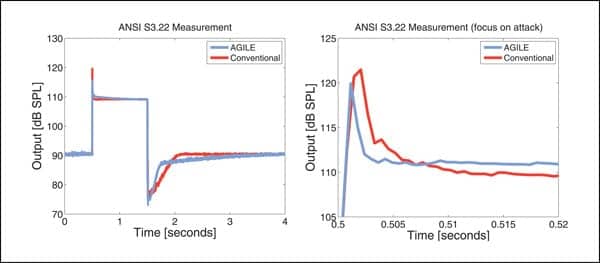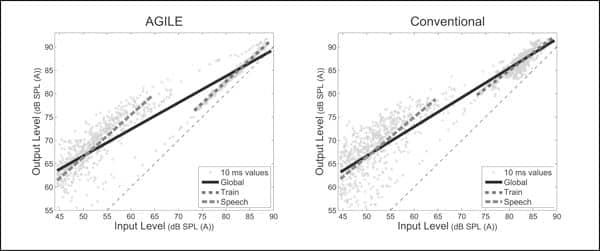A new compression system that is designed to allow for a freely variable overall compression ratio while maintaining near-linear performance for locally stable environments.

|

|
| This article was submitted to HR by Christian Stender Simonsen, MScEE, a development engineer at Oticon AS in Smørum, Denmark, and Thomas Behrens, MScEE, a research engineer at the Eriksholm Research Centre in Snekkersten, Denmark. Correspondence can be addressed to HR or Christian Stender Simonsen at . | |
The use of compression was controversial 15 years ago; however, most hearing aids produced today use compressive amplification strategies. Strictly linear amplifiers are typically considered outdated in hearing aids, primarily due to problems with audibility of soft sounds and discomfort of loud sounds. Compression takes care of these two problems and thus provides greater comfort compared to linear amplification.
However, compression does introduce other problems. It has been found that compression can reduce speech intelligibility if used inappropriately.1,2 Studies have also shown that hearing aid users often prefer less compression due to sound quality issues even though audibility and speech intelligibility might be reduced.3
This article describes a new compression system called the Adaptive GuIdance Level Estimator (AGILE), which is designed to enhance several quantifiable hearing aid parameters, such as speech intelligibility, comfort, and sound quality. This is done by combining slow and fast compression into a system that reacts rapidly if necessary and otherwise slowly—almost linearly.
The Basic Compressor
A compressor basically contains three components: 1) a level estimator/detector; 2) a compressor characteristic, and 3) an amplifier (Figure 1). The output signal of the compressor is obtained by amplifying the input signal with a time varying factor, which depends on both the level of the input signal and the compressor characteristic. The compressor characteristic and the amplifier can, in principle, apply the correct gain instantaneously.
The controversial part of the compressor is the level estimator. The level estimator cannot determine the nature of the incoming signal without looking at a certain time frame. If this time frame has a short duration, the compressor is likely to be fast-acting, whereas a long duration of the time frame will result in a slow-acting compressor.

|
| FIGURE 1. Simple diagram of a feed-forward compressor. The feed-forward compressor estimates the input level, then based on the input, it determines the necessary compression. The output of the compression characteristic is sent to a variable gain amplifier that amplifies the signal. The diagram only shows one channel operation, but additional channels could be added in parallel. |

|
| FIGURE 2. Simplified diagram of the level estimator inside AGILE. The centrally placed difference controller is further described in Figure 3. |
A New Compressor

|
| FIGURE 3. Display of how the AGILE difference controller operates. Based on differences between guided and fast estimates, it selects time constants. Negative differences mean that guided estimates are higher than fast estimates, implying the need to increase gain in compressive systems; positive differences imply a need to reduce gain. |
AGILE basically has the same building blocks as the traditional compressor shown in Figure 1. However, the crucial level estimator is enhanced in AGILE (Figure 2). The central element is a difference controller that constantly keeps track of the difference in estimates of the guided level estimate and the fast level estimate.
Figure 3 shows how the difference controller selects time constants based on the estimate difference. If differences between guided and fast level estimates are small, then time constants will be set to large values, and AGILE will operate as a slow-acting compression system. If differences are large, it will be fast-acting. Figure 3 also shows that positive and negative differences are not necessarily treated equivalently, meaning that attack and release times are different from each other.
In general, AGILE facilitates long time constants. If the input signal level is rather constant, the compressor moves slowly and acts almost linearly. With an abrupt change in input level, the level estimator is guided to a new level, which is closer to the level estimated by the fast level estimator. Therefore, in situations that require protection against sudden level changes, AGILE is capable of reacting very quickly. Similarly, if there is a sudden large drop in input level, the system will swiftly turn up gain. Thus, both effective attack and release times of the compressor are controlled by the dynamics of the input signal, and can vary almost instantly from a few milliseconds to multiple seconds.
In Figure 4, this operation is compared to that of a conventional compressor in an attack and release time measurement using the ANSI S3.22 standard. The conventional compressor was programmed to have attack- and release-times of approximately 5 ms and 320 ms, respectively; AGILE was set to have comparable attack and release times, although the adaptive dynamic behavior of this compressor makes attack and release time measures less meaningful. Looking at the release portion of the measurement, AGILE reacts fast at first, but once the level is within a certain range of the desired output, the adaptation speed is dramatically reduced. In contrast, the conventional compressor has an almost constant output level change per second during the release time.
Figure 4b shows a magnified version of Figure 4a, focusing on the attack of the two compressors. Again, AGILE reacts much faster than the conventional compressor in the beginning of the attack period, but once it is within a certain range of the target, it slows down, whereas the conventional compressor keeps a more steady pace until the target has been reached.

|
| FIGURE 4A-B. Attack- and release-time measurements for AGILE and an instrument with a conventional slow-acting compressor measured using a sinusoid at 1600 Hz as standardized in ANSI 3.22. The right graph (4b) is a magnified version of the left graph (4a), focusing on the attack time. |

|
| FIGURE 5A-B. Scatter plots of AGILE (left, 5a) and a conventional slow-acting compressor (right, 5b) measured on a HATS mannequin in an anechoic room. The signal was presented directly in front of the HATS (0°) and consisted of continuous male speech interfered by loud train whistles every 2 seconds. The two hearing aids were set to have a constant compression ratio (CR=2) above a kneepoint of 20 dBSPL and all automatic functions were turned off. On top of the scatter plots, three linear regression lines are shown: the speech and train portions, as well as one global regression line. |
Linear Behavior of New System
The scatter plots in Figures 5a-b show short-term RMS values of input and output signals from a 1/3-octave band centered at 2.5 kHz using 10 ms analysis time frames. (A similar picture was seen at other frequencies.) The input signal consisted of continuous male speech interrupted by loud train whistles that abruptly start and stop, making it easy to separate the two signals. Both AGILE and the conventional compressor were set to have a constant compression ratio of 2:1 above a kneepoint of 20 dBSPL. The conventional compressor was set to have attack and release times of approximately 5 and 320 ms, and AGILE was set to have comparable attack and release times.
Figure 5a shows how AGILE operates almost linearly in the speech and the train segments of the input signal. The conventional compressor (Figure 5b) also shows a tendency toward making two segments, but they are not as linear as AGILE.

|
| TABLE 1. The effective compression ratios calculated using linear regression analysis of the short-term RMS values shown in Figure 5. |
Effective compression ratios (CR) are estimated for both compressors in Table 1, calculated by using linear regression analysis of the short-term RMS values as shown in Figure 5a-b. The effective estimated CRs for AGILE are lower than those of the conventional compressor and are close to linear (CR = 1) in both the speech and the train segments of the input signal. It can also be seen in Table 1 that, for the total signal, AGILE has an estimated effective compression ratio that better matches the static compression ratio set to 2 in both compressors. So, even though we consider AGILE to be a slow compressor, Table 1 indicates it also enjoys the benefits of fast compressors seen from a global perspective.
A very fast-acting compressor would have had effective CRs of the global, the speech, and the train part of the signal close to the static CR (ie, CR = 2).
Thus, AGILE operates linearly whenever the signal only varies by a certain amount. Once a large level change occurs, it reacts rapidly according to the static compression ratio line. This behavior might allow the realization of CRs above the 3 to 4 range (typically seen as maximum CRs) without dramatically reducing sound quality. In this way, AGILE could open the possibility to directly prescribe compression characteristics for profound hearing losses without compromising the setting of time constants, compression ratios, and kneepoints.
User Benefits of the New Compressor
Speech intelligibility. Boike and Souza1 reported speech recognition scores for speech in noise increased with decreasing compression ratios. However, speech recognition scores for speech in quiet were not influenced by the magnitude of the compression ratio. Importantly, this suggests that, in difficult listening situations, linear amplification provides better speech intelligibility.
Stone and Moore2 drew a similar conclusion; fast-acting compression sometimes has deleterious effects on speech intelligibility when background sounds are present. This phenomenon is partially explained via comodulation of the target signal and the competing talkers on the output of the compressor. When people speak simultaneously, the gain at any instant is determined primarily by the louder talker. Peaks in one talker result in lower output levels of the other and vice versa, resulting in loss of intelligibility. Linear or slow-acting compression schemes, such as AGILE, do not present this disturbing effect.
Of note, fast compression can increase speech intelligibility for people who are capable of utilizing speech cues temporarily masked/unmasked4,5—a phenomenon often referred to as “listening in the dips.” The fact that AGILE reacts rapidly to an input level change provides the possibility for hearing aid users to listen in the dips.
Sound quality. Sound quality obviously is an important parameter when evaluating hearing aids.6 This is especially true for first-time users adapting to new sound processing schemes that are totally different from what they were used to.7 Neuman et al,8 Van Buuren et al,9 and Boike and Souza1 all reported degradation in perceived sound-quality ratings for increasing compression ratios. Souza3 concluded that clients generally prefer the sound quality of the least complex processing.

|
| FIGURE 6. Mean air-conduction thresholds for the test group with error bars reflecting ±1 standard deviation around the mean. |

|
| FIGURE 7. Overall preference. No subjects preferred their own aids over the experimental (AGILE) hearing aids. |

|
| FIGURE 8. The experimental aids showed higher mean ratings on comfort, speech intelligibility, sound quality, and overall rating. |
Comfort. Gatehouse et al10 determined that slow-acting compression provided more listening comfort than linear processing, fast-acting compression, and a combination with fast-acting and slow-acting compression in the low- and high-frequency channels. With a slow-acting compression scheme, end users generally expend less effort listening, especially in competing noise.
In acoustic environments with sudden loud transients, AGILE attacks almost instantly, protecting the user from unpleasant and potentially damaging noises. Further, previous slow-acting compressors have effectively shut down shortly during the release period, causing the end user to lose valuable speech cues. The fast onset of the release period for AGILE acts to preserve those same speech cues.
Some hearing aid manufacturers have recently introduced transient noise reduction systems that provide protection for the hearing aid user.11 AGILE incorporates built-in transient protection.

|
| FIGURE 9. Speech intelligibility scores for own versus experimental aid, with the latter having higher mean ratings in all speech situations. |

|
| FIGURE 10. All sound quality scores showed higher mean ratings of the experimental hearing aids over the users’ own instruments. |

|
| FIGURE 11. Comfort scores for own versus experimental aids. In all three conditions, the experimental aids had higher mean ratings. |
Preliminary Field Study Using New System
Some end users have already tested AGILE in an experimental hearing aid. Figure 6 shows mean air conduction thresholds for a group of 10 experienced hearing aid users who participated in a preliminary field trial of the new compression system.
The purpose of the trial was to investigate if the new compressor would improve sound quality, speech intelligibility, and comfort. The experimental hearing aid was tested against the users’ own instruments. All subjects used modern premium instruments. A total of 6 subjects wore RITE styles and 4 used BTE styles. Test subjects were fitted with experimental test aids and used them for 2 weeks in their daily life environments. Subjects were instructed to primarily use the experimental hearing aids, but if needed they could put on their own aids for comparison purposes. During and after the 2-week trial period, subjects completed a questionnaire focusing on sound quality, speech intelligibility, and comfort.
The experimental hearing aids were programmed with the same amplification rationale, noise reduction, directionality settings, etc, as their own hearing aids, to maximally assure AGILE as the key variable between the experimental and their own hearing aids. Furthermore, the shell design of the experimental hearing aids and the users’ own instruments was identical.
Figure 7 demonstrates subjects’ overall preference ratings of the experimental hearing aid as compared to their own instruments. In total, 7 of 10 subjects preferred the experimental hearing aid over their own instrument, and 3 subjects had no preference.
Figure 8 shows ratings with regard to comfort, speech intelligibility, and sound quality, as well as an overall rating. For the three subscales, there was a significant overall difference (p < 0.05) between their own instrument and the experimental hearing aid in a repeated measures analysis. The overall rating was also significantly higher in favor of the experimental hearing aid as compared to the users’ own instruments (p < 0.05, two-tailed t-test). Thus, on an overall scale, clients preferred the experimental hearing aid over their own instruments.
Figure 9 demonstrates detailed ratings for speech intelligibility in multiple listening environments. Mean ratings were higher for the experimental hearing aid in every listening environment. Grouping all speech intelligibility subscales in a t-test did provide a significant result (p < 0.05), thus demonstrating end users rated the experimental hearing aids higher than their own with regard to speech intelligibility.
Figure 10 shows detailed ratings for specific sound quality situations. The experimental hearing aid had higher mean ratings on every subscale than the subjects’ own instruments.
Figure 11 demonstrates detailed ratings for comfort. On all subscales, the experimental hearing aid had higher mean ratings than their own hearing aid. Grouping the three subscales created a statistically significant higher rating (p < 0.05, two-tailed t-test) for the experimental hearing aid, implying that the subjects preferred the comfortable sound of AGILE.
Acknowledgement
The authors would like to express our appreciation to Joachim Neumann for his extensive work on developing AGILE. We would also like to thank Jan Petersen and Signe Frølund Albeck for defining, setting up, and running the preliminary field trial with AGILE.
References
- Boike KT, Souza PE. Effect of compression ratio on speech recognition and speech-quality ratings with wide dynamic range compression amplification. J Speech Hear Res. 2000;43:456-468.
- Stone MA, Moore BCJ. Effects of spectro-temporal modulation changes produced by multi-channel compression on intelligibility in a competing-speech task. J Acoust Soc Am. 2008;123:1063-1076.
- Souza PE. Effects of compression on speech acoustics, intelligibility, and sound quality. Trends Amplif. 2002;6:131-165.
- Gatehouse S, Naylor G, Elberling C. Benefits from hearing aids in relation to the interaction between the user and the environment. Int J Audiol. 2003;42:77-85.
- Lunner T, Sundewall-Thorén E. Interactions between cognition, compression, and listening conditions: effects on speech-in-noise performance in a two-channel hearing aid. J Am Acad Audiol. 2007;18:604-617.
- Sockalingam R, Beilin J, Beck DL. Sound quality considerations of hearing instruments. Hearing Review. 2009;16(3):22-28.
- Ovegård A, Lundberg G, Hagerman B, Gabrielsson A, Bengtsson M, Brandstrom U. Sound quality judgement during acclimatization of hearing aid. Scand Audiol. 1997;26:43-51.
- Neuman AC, Bakke MH, Mackersie C, Hellman S, Levitt H. The effect of compression ratio and release time on the categorical rating of sound quality. J Acoust Soc Am. 1998;103:2273-2281.
- Van Buuren RA, Festen JM, Houtgast T. Compression and expansion of the temporal envelope: evaluation of speech intelligibility and sound quality. J Acoust Soc Am. 1999;105:2903-2913.
- Gatehouse S, Naylor G, Elberling C. Linear and nonlinear hearing aid fittings—1. Patterns of benefit. Int J Audiol. 2006;45:130-152.
- Chalupper J, Powers TA. New algorithm is designed to take the annoyance out of transient noise. Hear Jour. 2007;60:42-48.
Citation for this article:
Simonsen CS, Behrens T. A new compression strategy based on a guided level estimator. Hearing Review. 2009;16(13):26-31.





